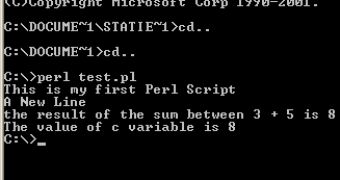Perl is a programming language that is very easy to learn. In order to begin, you will need to download and install a Perl distribution package compatible with your operating system. You can get the latest Perl version from perl.com website.
To simplify the Perl installation it is recommended to use ActivePerl from Active State, because this Perl distribution is pre-configured to provide an automatic installation of Perl on any operating system. After you select the free Windows distribution package, download it and the automatic installer will configure Perl to work on your operating system.
You can check if Perl was installed successfully on your system by typing in a DOS command.com window: perl -v. You should see the Perl version information in the same window. Now, you are ready to deploy your first Perl script.
Let's consider the next code example:
";
print "A New Line
";
$a = 3;
$b = 5;
$c = $a+$b;
print 'the result of the sum between '.$a.' + '.$b.' is '.$c;
print"
";
print "The value of c variable is $c";
The print function allows you to display strings and variables. To display text or variables values on a new line the directive must be specifyed. $a, $b and $c are scalar variables. A variable is denoted by the $ sign in Perl programming language. The sum of variables $a and $b is stored in the $c variable, whose value is outputed in lines 6 and 8 using different coding techniques.
This Perl short introduction should be enough to understand the simplicity of this programming language. If you have a previous programming experience with PHP, C or C++, Perl language will be easily understood and implemented in your next scripts. The next step should be towards employing Perl in CGI scripts to create dynamic server side web pages and applications.

 14 DAY TRIAL //
14 DAY TRIAL //